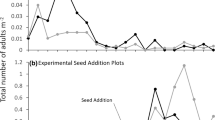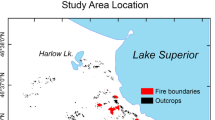Abstract
Seed predation may cause important seed losses in plant populations, but its impact on the dynamics of populations will depend on the degree of seed or microsite limitations for recruitment. Seed losses will only affect recruitment if it is seed limited. The nature of recruitment limitation (seeds or microsites) is usually ascribed to whole plant populations but it may vary within populations among microhabitats and habitats. Thus, the potential impact of seed predation will also vary within the population, being highest where recruitment is seed limited. The impact to the whole population will depend on the spatial concordance between the intensity of seed predation and that of seed limitation. Recruitment limitations (with seed addition experiments), seed predation (with seed removal experiments), and the dynamics of seed availability in the soil (with soil samples taken both after seed dispersal and before the following dispersal event) of the shrub Corema album (Empetraceae) were investigated in dunes in NW Spain, at microhabitats ‘open ground’, ‘underneath C. album ♀’, and ‘underneath C. album ♂’ at two habitats, sparse and dense scrub. The nature of recruitment limitation (seeds vs. microsites) varied within the population. It was seed limited in the microhabitat ‘open ground’ and microsite limited under shrub cover. The spatial patterns of seedling recruitment were unrelated to seed availability but strongly affected by germination requirements. The spatial discordance between seed availability and recruitment implies a crucial constraint for processes affecting seed availability (seed predation but also e.g., dispersal) to impact recruitment. They will not affect its spatial pattern but only its quantity as long as they act in those sites selected by seeds to germinate. Seed predation was highest underneath mother plants and lowest in open ground. Thus, its potential impact is low, as it is centred where recruitment is not seed limited. This study shows that the analysis of seed predation in relation to recruitment limitations at smaller spatial scales within the population provides more insight to understand its impact.




Similar content being viewed by others
References
Alcántara JM, Rey PJ, Sánchez-Lafuente AM, Valera F (2000) Early effects of rodent post-dispersal seed predation on the outcome of the plant-disperser interaction. Oikos 88:362–370
Andersen AN (1989) How important is seed predation to recruitment in stable population of long-lived perennials? Oecologia 81:310–315
Bazzaz FA (1991) Habitat selection in plants. Amer Nat 137:116–130
Calviño-Cancela M (2002) Spatial patterns of seed dispersal and seedling recruitment in Corema album (Empetraceae): the importance of unspecialized dispersers for regeneration. J Ecol 90:775–784
Calviño-Cancela M (2003) Ecología de la reproducción de Corema album (L.) D. Don (Empetraceae): Implicaciones para su conservación. PhD thesis, Universidade de Vigo, Spain
Calviño-Cancela M (2004) Ingestion and dispersal: Direct and indirect effects of frugivores on seed viability and germination of Corema album (Empetraceae). Acta Oecol 26:55–64
Carballeira A, Devesa C, Retuerto R, Santillán E, and Ucieda F (1983) Bioclimatología de Galicia. Fundación Pedro Barrié de La Maza, A Coruña, Spain
Castroviejo S, Aedo C, Gómez Campo C, Lainz M, Monserrat P, Morales R, Muñoz Garmendia F, Nieto Feliner G, Rico E, Talavera S, and Villar L (1986–97) Flora Ibérica, vols. I–VIII. Servicio de Publicaciones del CSIC, Madrid
Crawley MJ (1989) Insect herbivores and plant population dynamics. Annu Rev Entomol 34:531–564
Crawley MJ (1990) The population dynamics of plants. Philos Trans Roy Soc B 330:125–140
Crawley MJ (1993) GLIM for Ecologists Blackwell, Oxford
Crawley MJ (2000) Seed predators and plant population dynamics. In: Fenner M (eds) Seeds: the ecology of regeneration in plant communities, 2nd ed. CAB International, London, pp 167–182
Díaz M (1992) Rodent seed predation in cereal crop areas of central Spain: effects of physiognomy, food availability and predation risk. Ecography 15:77–85
Eriksson O, Ehrlén J (1992) Seed and microsite limitation of recruitment in plant populations. Oecologia 91:360–364
García D, Obeso JR, Martínez I (2005) Spatial concordance between seed rain and seedling establishment in bird-dispersed trees: does scale matter? J Ecol 93:693–704
García D, Zamora R, Gómez JM, Hódar JA (2002) Annual variability in reproduction of Juniperus communis L. in a Mediterranean mountain: relationship to seed predation and weather. Écoscience 9:251–255
Guitián P, Medrano M, Rodríguez M (1997) Reproductive biology of Corema album (L.) D. Don (Empetraceae) in the northwest Iberian Peninsula. Acta Bot Gal 144:119–128
Harper JL (1977) Population biology of plants. Academic Press, London
Herrera CM (1998) Long-term dynamics of Mediterranean frugivorous birds and fleshy fruits: a 12-year study. Ecol Monogr 68: 511–538
Houle G (1995) Seed dispersal and seedling recruitment: the missing link. Écoscience 2:238–244
Hulme PE (1993) Post-dispersal seed predation by small mammals. Symp Zool Soc Lond 65:269–287
Hulme PE (1994) Post-dispersal seed predation in grassland: its magnitude and sources of variation. J Ecol 82:645–652
Hulme PE (1996) Natural regeneration of yew (Taxus baccata L.): microsite, seed or herbivore limitation? J Ecol 84:853–861
Hulme PE (1997) Post-dispersal seed predation and the establishment of vertebrate dispersed plants in Mediterranean scrublands. Oecologia 111:91–98
Hulme PE (1998) Post-dispersal seed predation: consequences for plant demography and evolution. Perspect Plant Ecol Evol Syst 1:32–46
Hulme PE (2002) Seed-eaters: seed dispersal, destruction and demography In: Levey D, Galetti M, Silva W (eds) Frugivores and seed dispersal: ecological, evolutionary and conservation issues. CAB International, Wallingford, pp 339–350
Hulme PE, Benkman CW (2002) Granivory. In: Herrera CM, Pellmyr O (eds) Plant animal interactions. An evolutionary approach. Blackwell Science, Oxford, pp 132–154
Hulme PE, Kollmann J (2005) Seed predator guilds, spatial variation in post-dispersal seed predation and potential effects on plant demography: a temperate perspective. In: Forget PM, Lambert PE, Hulme PE, Vander Wall SB (eds) Seed fate. Predation, dispersal and seedling establishment. CABI Publishing, Wallingford
Jordano P, Herrera CM (1995) Shuffling the offspring: uncoupling and spatial discordance of multiple stages in vertebrate seed dispersal. Écoscience 2:230–237
Juenger T, Bergelson J (2000) Factors limiting rosette recruitment in scarlet gilia, Ipomopsis aggregata: seed and disturbance limitation. Oecologia 123:358–363
Klinkhamer PGL, de Jong TJ (1989) A deterministic model to study the importance of density-dependence for regulation and the outcome of intra-specific competition in populations of sparse plants. Acta Bot Neerland 38:57–65
Lima SL, Dill LM (1990) Behavioral decisions made under the risk of predation: a review and prospectus. Can J Zool 68:619–640
Manson RH, Stiles EW (1998) Links between microhabitat preferences and seed predation by small mammals in old fields. Oikos 82:37–50
Marchante H, Marchante E, Freitas H (2003) Invasion of the Portuguese dune ecosystems by the exotic species Acacia longifolia (Andrews) Willd.: effects at the community level. In: Child LE, Brock JH, Brundu G, Prach K, Pysěk P, Wade PM, Williamson M (eds) Plant invasions: ecological threats and management solutions. Backhuys, Leiden, The Netherlands, pp 75–85
Maron JL, Gardner SN (2000) Consumer pressure, seed versus safe-site limitation, and plant population dynamics. Oecologia 124:260–269
Maron JL, Simms EL (2001) Rodent-limited establishment of bush lupine: field experiments on the cumulative effect of granivory. J Ecol 89:578–588
Morrison DF (1990) Multivariate statistical methods, 3rd ed. McGraw-Hill, New York
Münzbergová Z, Herben T (2005) Seed, dispersal, microsite, habitat and recruitment limitation: identification of terms and concepts in studies of limitations. Oecologia 145: 1–8
Schupp EW (1995) Seed-seedling conflicts, habitat choice, and patterns of plant recruitment. Amer J Bot 82:399–409
Schupp EW, Fuentes M (1995) Spatial patterns of seed dispersal and the unification in plant population ecology. Écoscience 2:267–275
Serio-Silva JC, Rico-Gray V (2002) Influence of microclimate at different canopy heights on the germination of Ficus (Urostigma) seeds dispersed by Mexican howler monkeys (Alouatta palliata mexicana). Interciencia 27:186–190
Simonetti JA (1989) Microhabitat use by small mammals in central Chile. Oikos 56:309–318
Turnbull LA, Crawley MJ, Rees M (2000) Are plant populations seed-limited? A review of seed sowing experiments. Oikos 88:225–238
von Ende CN (1993) Repeated-measures analysis: growth and other time-dependent measures. In: Scheiner SM, Gurevitch J (eds) Design and analysis of ecological experiments. Chapman and Hall, London, pp 113–137
Acknowledgements
I thank Johannes Kollmann, Daniel García, Adolfo Cordero and two anonymous referees for their comments. The Servicio de Medio Ambiente Natural (Pontevedra) for the permit to work in the Cíes Islands and the staff there for logistic support. Part of this research was founded by project PGIDT01MAM37101PR from Xunta de Galicia and fellowships from Secretaría Xeral de I+D (Xunta de Galicia).
Author information
Authors and Affiliations
Corresponding author
Rights and permissions
About this article
Cite this article
Calviño-Cancela, M. Seed and microsite limitations of recruitment and the impacts of post-dispersal seed predation at the within population level. Plant Ecol 192, 35–44 (2007). https://doi.org/10.1007/s11258-006-9223-3
Received:
Accepted:
Published:
Issue Date:
DOI: https://doi.org/10.1007/s11258-006-9223-3




